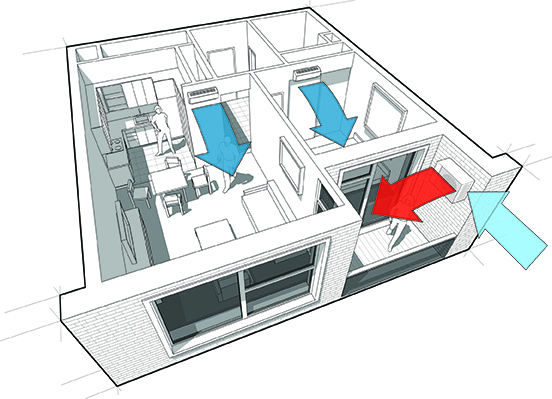If you study combustion, you understand that you get better combustion with hotter air, warmer fuel, and a hotter flame. From purely a science standpoint, combustion is the process of oxidation, regardless of the fuel.
Oxidation is the rapid movement of molecules that produces heat. I believe cold outside air does not conform to this scientific fact! So why is it still recommended?
One question you might ask is what makes a cold climate cold? I would assume “cold” would be when temperatures drop below 32 degrees. Is that right? Another question might be, why haven’t we changed or updated anything?
Another Study by ASHRAE
In 2000, ASHRAE published a general study on combustion air, not specific to cold climates. This study found that the amount of passive combustion air required by national building codes does not work under many environmental conditions. However, mechanical or fan-powered combustion air was effective under almost all conditions.
The report also stated that national building codes don’t allow for professionally installed systems. Twenty-one years later, we are still using undependable combustion air standards. When asked why, authorities only say it is better than nothing! Why hasn’t anything changed?

Don’t we believe in science?
The Common Factor
When it comes to HVAC system test procedures for checking combustion air, there are many out there. Yet almost none confirm that combustion air is getting to the equipment. Maybe without testing, we should know there is plenty of air in the room because we are breathing.
This is why National Comfort Institute (NCI) stresses and teaches the best method to determine combustion air performance, and then how to control or correct it!
Altitude’s Impact on Combustion
Some studies deal with de-rating new furnaces at higher altitudes. The first known study was in 1933. This study was performed in altitude chambers in a lab, using a fuel rated for sea level.
That study led to the rule for de-rating 4% for every 1000 feet above sea level.
Fuel Btus at sea level are about 1000 Btus per cubic foot or slightly higher. It is possible in 1933 that this was the same Btu formula used at high altitudes. However, this case study doesn’t mention that.
How about a new study at the actual altitudes?
In 2007, there was a published report on the de-rating of mainly gas-fired induced draft furnaces at higher altitudes. The study’s goal was to determine if it was still necessary to de-rate equipment 4% for every 1000 feet of altitude above 2000 feet.
In this case they studied five identical furnaces at three altitudes: sea level, 2230 feet, and 6700 feet. Nothing in the report shows they tested at any higher altitude. The furnaces used natural gas and propane fuel.
Although the report says they used the same amount of gas Btus on all equipment, they didn’t mention the number of Btus used. Assuming it was gas normally used at sea level, the natural gas was about 1000 Btus per cu.ft. and the propane was 90,000 Btus per gallon.
Click Below for the Next Page:













Opinions are untested hypotheses. Once scrutinized under scientific method, a hypothesis can become repeatable and proven and thereby “Science.” Science requires sharp critical thinking free of bias and error.